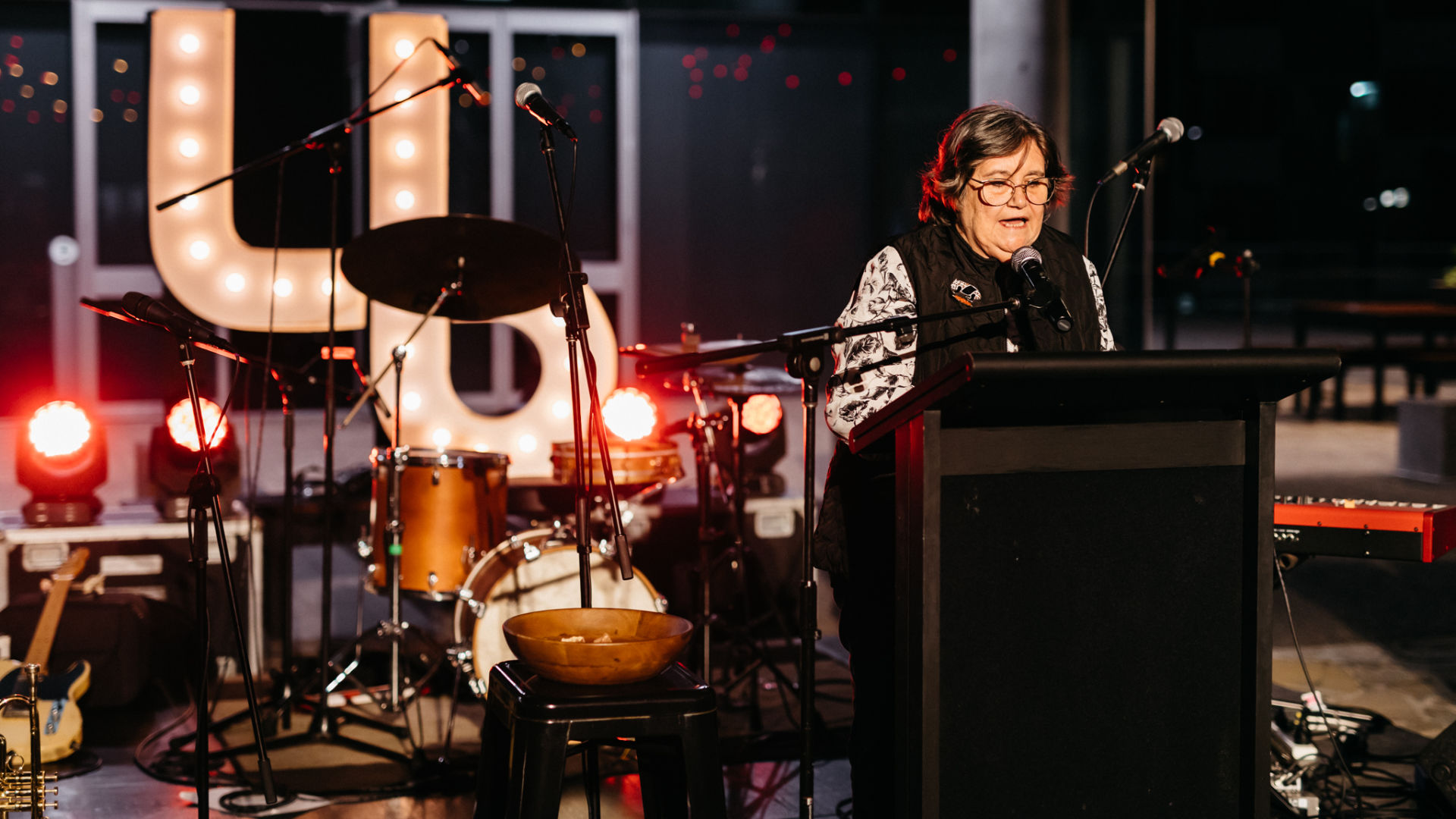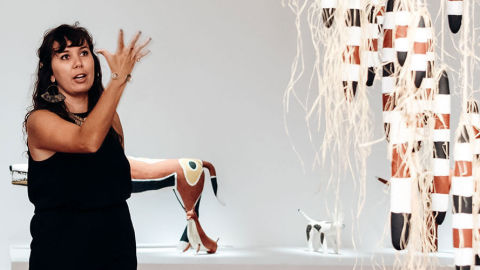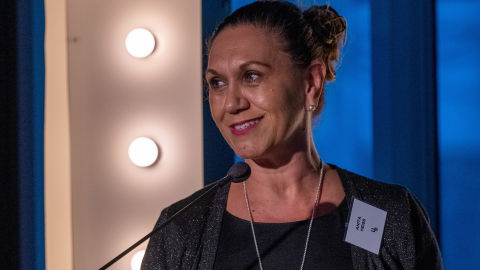Blog
A message from Aunty Colleen on NAIDOC Week

Aunty Colleen speaking at lectern on La Boite stage. Image credit: Markus Ravik
La Boite's Cultural Advisor, Aunty Colleen Wall, shares her story and how storytelling can 'Heal Country'.
I am a Senior Marun Dauwa Kau’bvai Woman from the Mary River watershed in Widebay and a descendant of the Minniecon/Beezley families. As a Grandmother, part of my responsibilities is to ensure my Grandchildren know the stories of our Country, so I guess I am a storyteller. I chose to paint these stories and to paint their Murung (Meat) or ‘special beings’ into those stories so they can identify them anywhere. We all have three Murung – being Personal, Clan and Nation. Our responsibility is to teach children about the ecosystem around their three Murung so that they survive forever, which means they have to protect the environment (water, air and earth) that each relies on.
"As a Grandmother, part of my responsibilities is to ensure my Grandchildren know the stories of our Country, so I guess I am a storyteller."
Each person in my family has a different ‘personal’ Murung. Mine is Marun (Sand or burrowing Goanna) while the other two are - Dauwa Clan (Stringy Bark Tree) and - Kau’bvai Nation (Light-honey Bee). These stay the same as they are a family and extended families responsibility to our Country, the Mary River watershed.
The western side of my homeland is bounded by the Coastal Range, a section of the Great Dividing Range. A First Nation Ancient Pathway still ‘travels’ along this Range and continues on to encircle, what is now known as, Australia. This path is actually a ‘free-way’ that runs between the Nations of each watershed and serves as a wet-weather track, as it is well above the high-water mark. The dry-weather tracks run alongside rivers and close to water sources like spring-fed lagoons, as these are close to other resources. It is these tracks that adjoin each major water-source, usually being connected to our Freshwater Dreaming Stories, which carries a Land Law that protects these valuable resources as sacred sites. Scientists are now linking our ancient Land Law stories to ancient sea-level rises with many proving to be in line with modern scientific knowledge. Some of our stories relate back to the last sea-level rise and others go back further. Now we can categorically say that the Freshwater Dreaming story, handed down to us from my Great-great Grandmother, is between 10-20,000 years old.
In March 1823, two ticket-of-leave men, Pamphlett and Parsons along with Finnegan a full-convict, were blown north from Sydney in a storm, landing on an island in what is now known as Moreton Bay, where they lived with the local Traditional Owners until they were found 8 months later. In 1825, convicts were relocated to the Brisbane River, thus beginning a new colony. Pamphlett gained local knowledge during his time around Redcliffe, Toorbul, and Bribie Island, which influenced new exploration within the Maroochy, Tewantin, Noosa, and Wide Bay areas.
In 1842, Henry Russell, a Darling Downs squatter, looking for better sheep country, joined Andrew Petrie who sailed a whale-boat from Brisbane to Wide Bay looking for timber. These were the first Europeans to sail into Muruba’Kgula, the sacred good-water river on our Kau’bvai Country. During this trip they found Bracewell and Davis, two absconders, who were later appointed to the Border Police. They used the knowledge we taught them against us in the future.
"During this trip they found Bracewell and Davis, two absconders, who were later appointed to the Border Police. They used the knowledge we taught them against us in the future."
In November 1842, Russell made another expedition to Wide Bay country. He found and named the Boyne River, which actually turned out to be the head of the Burnett River. He found good land and took up Burrandowan Station on Davis’s advice. He also met the botanist, John Carne Bidwill on this journey and showed him where to access specimens of the Bunya Pine (Araucaria bidwillii) and Bidwill sent three to the London Botanical Society. These are sacred tree ancestors of the Clans south of Dauwa Country, which are still celebrated through ceremonial festivals in the Bunya scrubs between Brisbane and Wide Bay today.
In 1844, Ludwig Leichardt met Aboriginal groups travelling for Bunya Festival, and Tom Petrie also attended with 100 Brisbane Aborigines travelling to Baroon Pocket near Kenilworth in the Blackall Ranges as guests of the Kau’bvai - Kabi people.
Our Dauwa Clan was one of the first to be directly impacted by disputes over land and resources in the Wide Bay region, after Petrie reported the abundance of timber for building resources. By 1846, thirteen squatters took up land along the Wide Bay River system (now Mary River). To build their port, people began cutting down our sacred hardwood trees such as Red Cedar, Bunya and Queensland Kauri Pine, including our sacred Murung, the Dauwa (Stringy Bark Trees) to build shops, homes, boats and jetties.
They didn’t ask if they could take our valuable Kau’bvai (Kabi) resources, they just assumed that these carefully cultivated and respected trees didn’t belong to anyone. This offensive action caused our ancestors to protect that which we held generational responsibility for, our precious Dauwa Murung (Stringy Bark Being). To Dauwa people our ancestor Stringy Bark tree-sap is like our blood, it’s in our DNA. They are our grandmother’s and grandfathers.
"There was no thought of sharing land or resources and eventually there was no land left for us. This broke all cultural links to our Lands. So our people were progressively driven from their traditional lands into missions."
The Kau’bvai forest giants were amongst the first ancient Murung to be felled for timber and their rainforest habitat cleared for farming. There was no thought of sharing land or resources and eventually there was no land left for us. This broke all cultural links to our Lands. So our people were progressively driven from their traditional lands into missions.
In 1847, the Port of Maryborough opened and was declared a port of entry, meaning that overseas and intercolonial vessels could arrive and depart direct, to export meat, wool and timber and to import necessary goods.
During the disputes over Land and resources, our men fought with spears to protect our resources, but the new people shot them all. So, my Great-Great-Great Grandmother who we only know as Nannie fled north from Kau’bvai to Gurang Country to family who has married that way. My Granny Mary Minniecon married Bert Beezley whose family were horse-breakers and trainers as well as drovers. During the bombing of Darwin, my Granny Mary moved her family to Eidsvold in Wakka Country on the Burnett River and I was born there. My Mum met my Dad, Herb Geiszler, there. He was also a drover and horse breaker/trainer, so I am a 5th generation drover who loves the bush. My Dad died when I was 12 and Mum moved us to Bundaberg. Twelve years later I was living in Kilkivan, married with a son and a daughter, and drawing in pencil and ink. Fourteen years later I am a widow working in Brisbane as the first Aboriginal Project Officer in the then Queensland Office of the Arts (Arts Queensland).
"I think the only way to heal our Country is to continue to remind it of the stories it holds."
I think the only way to heal our Country is to continue to remind it of the stories it holds. To continue to talk to it in language, remind it how important it is to us as a Land-based people who have its DNA imprinted in our blood and in our hearts. To let it hear us whisper to the trees and the birds and animals about how much we, who live out of Country, miss the smell of its flowers, the sound of its bees and the feel of its breeze on our face and its water on our feet as we dangle them into the cool babbling streams, running from our sacred springs that are nurtured by Kung Ngar’vung the Water Mother.
"We must always tell our Mother Earth how much we love her. That is the only way we can heal her."
"As a Grandmother, part of my responsibilities is to ensure my Grandchildren know the stories of our Country, so I guess I am a storyteller."
Each person in my family has a different ‘personal’ Murung. Mine is Marun (Sand or burrowing Goanna) while the other two are - Dauwa Clan (Stringy Bark Tree) and - Kau’bvai Nation (Light-honey Bee). These stay the same as they are a family and extended families responsibility to our Country, the Mary River watershed.
The western side of my homeland is bounded by the Coastal Range, a section of the Great Dividing Range. A First Nation Ancient Pathway still ‘travels’ along this Range and continues on to encircle, what is now known as, Australia. This path is actually a ‘free-way’ that runs between the Nations of each watershed and serves as a wet-weather track, as it is well above the high-water mark. The dry-weather tracks run alongside rivers and close to water sources like spring-fed lagoons, as these are close to other resources. It is these tracks that adjoin each major water-source, usually being connected to our Freshwater Dreaming Stories, which carries a Land Law that protects these valuable resources as sacred sites. Scientists are now linking our ancient Land Law stories to ancient sea-level rises with many proving to be in line with modern scientific knowledge. Some of our stories relate back to the last sea-level rise and others go back further. Now we can categorically say that the Freshwater Dreaming story, handed down to us from my Great-great Grandmother, is between 10-20,000 years old.
In March 1823, two ticket-of-leave men, Pamphlett and Parsons along with Finnegan a full-convict, were blown north from Sydney in a storm, landing on an island in what is now known as Moreton Bay, where they lived with the local Traditional Owners until they were found 8 months later. In 1825, convicts were relocated to the Brisbane River, thus beginning a new colony. Pamphlett gained local knowledge during his time around Redcliffe, Toorbul, and Bribie Island, which influenced new exploration within the Maroochy, Tewantin, Noosa, and Wide Bay areas.
In 1842, Henry Russell, a Darling Downs squatter, looking for better sheep country, joined Andrew Petrie who sailed a whale-boat from Brisbane to Wide Bay looking for timber. These were the first Europeans to sail into Muruba’Kgula, the sacred good-water river on our Kau’bvai Country. During this trip they found Bracewell and Davis, two absconders, who were later appointed to the Border Police. They used the knowledge we taught them against us in the future.
"During this trip they found Bracewell and Davis, two absconders, who were later appointed to the Border Police. They used the knowledge we taught them against us in the future."
In November 1842, Russell made another expedition to Wide Bay country. He found and named the Boyne River, which actually turned out to be the head of the Burnett River. He found good land and took up Burrandowan Station on Davis’s advice. He also met the botanist, John Carne Bidwill on this journey and showed him where to access specimens of the Bunya Pine (Araucaria bidwillii) and Bidwill sent three to the London Botanical Society. These are sacred tree ancestors of the Clans south of Dauwa Country, which are still celebrated through ceremonial festivals in the Bunya scrubs between Brisbane and Wide Bay today.
In 1844, Ludwig Leichardt met Aboriginal groups travelling for Bunya Festival, and Tom Petrie also attended with 100 Brisbane Aborigines travelling to Baroon Pocket near Kenilworth in the Blackall Ranges as guests of the Kau’bvai - Kabi people.
Our Dauwa Clan was one of the first to be directly impacted by disputes over land and resources in the Wide Bay region, after Petrie reported the abundance of timber for building resources. By 1846, thirteen squatters took up land along the Wide Bay River system (now Mary River). To build their port, people began cutting down our sacred hardwood trees such as Red Cedar, Bunya and Queensland Kauri Pine, including our sacred Murung, the Dauwa (Stringy Bark Trees) to build shops, homes, boats and jetties.
They didn’t ask if they could take our valuable Kau’bvai (Kabi) resources, they just assumed that these carefully cultivated and respected trees didn’t belong to anyone. This offensive action caused our ancestors to protect that which we held generational responsibility for, our precious Dauwa Murung (Stringy Bark Being). To Dauwa people our ancestor Stringy Bark tree-sap is like our blood, it’s in our DNA. They are our grandmother’s and grandfathers.
"There was no thought of sharing land or resources and eventually there was no land left for us. This broke all cultural links to our Lands. So our people were progressively driven from their traditional lands into missions."
The Kau’bvai forest giants were amongst the first ancient Murung to be felled for timber and their rainforest habitat cleared for farming. There was no thought of sharing land or resources and eventually there was no land left for us. This broke all cultural links to our Lands. So our people were progressively driven from their traditional lands into missions.
In 1847, the Port of Maryborough opened and was declared a port of entry, meaning that overseas and intercolonial vessels could arrive and depart direct, to export meat, wool and timber and to import necessary goods.
During the disputes over Land and resources, our men fought with spears to protect our resources, but the new people shot them all. So, my Great-Great-Great Grandmother who we only know as Nannie fled north from Kau’bvai to Gurang Country to family who has married that way. My Granny Mary Minniecon married Bert Beezley whose family were horse-breakers and trainers as well as drovers. During the bombing of Darwin, my Granny Mary moved her family to Eidsvold in Wakka Country on the Burnett River and I was born there. My Mum met my Dad, Herb Geiszler, there. He was also a drover and horse breaker/trainer, so I am a 5th generation drover who loves the bush. My Dad died when I was 12 and Mum moved us to Bundaberg. Twelve years later I was living in Kilkivan, married with a son and a daughter, and drawing in pencil and ink. Fourteen years later I am a widow working in Brisbane as the first Aboriginal Project Officer in the then Queensland Office of the Arts (Arts Queensland).
"I think the only way to heal our Country is to continue to remind it of the stories it holds."
I think the only way to heal our Country is to continue to remind it of the stories it holds. To continue to talk to it in language, remind it how important it is to us as a Land-based people who have its DNA imprinted in our blood and in our hearts. To let it hear us whisper to the trees and the birds and animals about how much we, who live out of Country, miss the smell of its flowers, the sound of its bees and the feel of its breeze on our face and its water on our feet as we dangle them into the cool babbling streams, running from our sacred springs that are nurtured by Kung Ngar’vung the Water Mother.
"We must always tell our Mother Earth how much we love her. That is the only way we can heal her."
#More you might be interested in...

Five events to attend during Black History Month
By Nadine McDonald-Dowd
For All Media Enquiries Please Contact Aruga PR Agency
Senior Account Manager
Claire Bonney
Senior Account Executive
